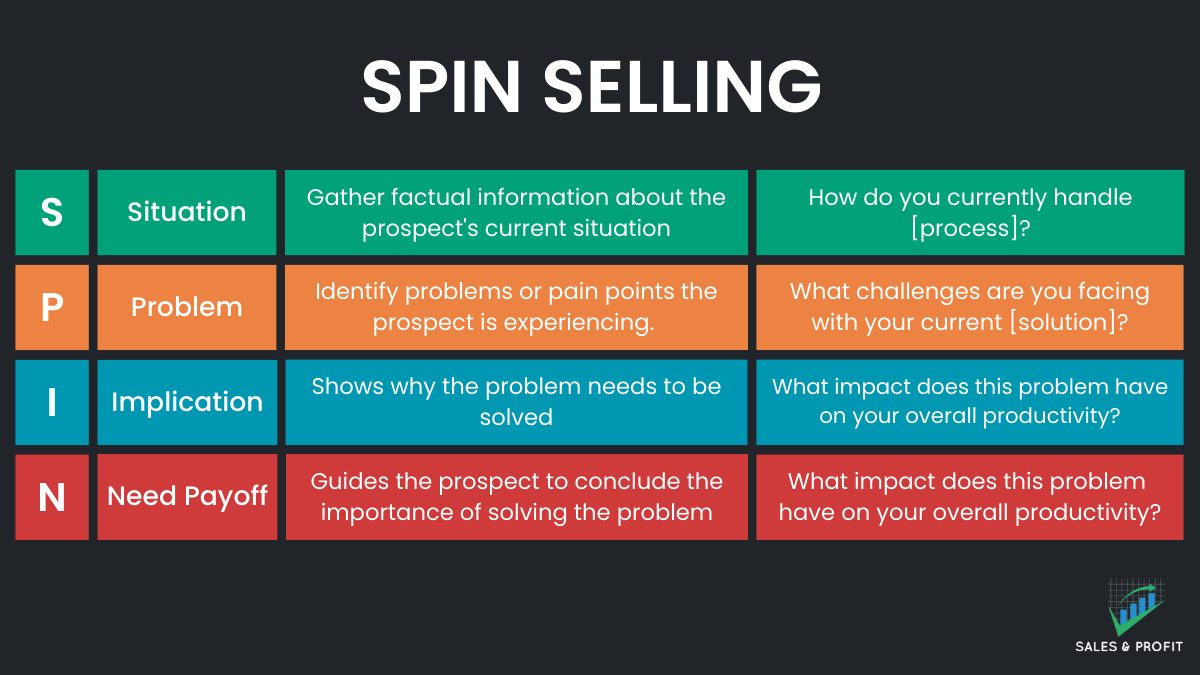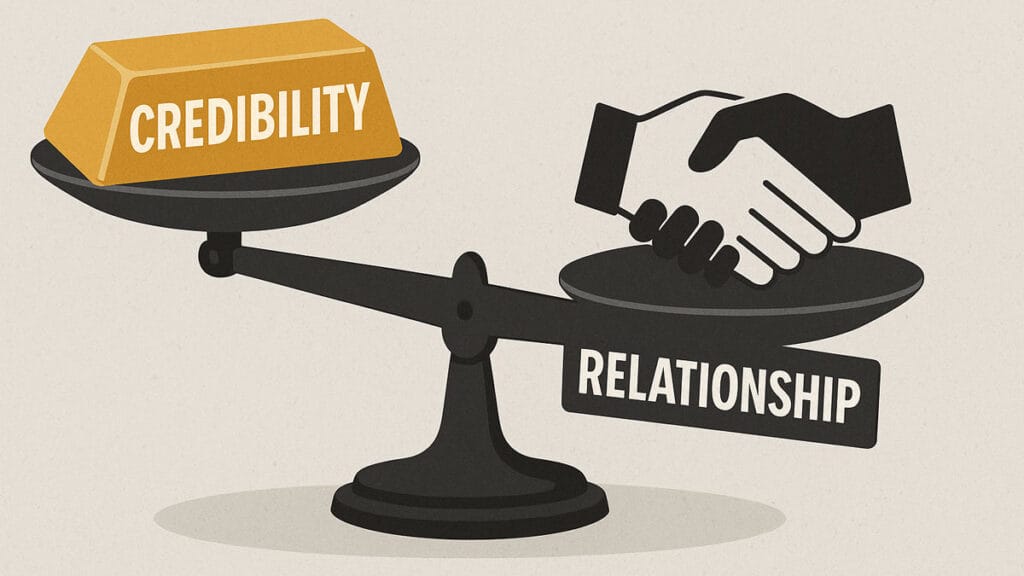Table of Contents
In my experience sales is all about understanding the prospect’s needs, pain points, and challenges.
This understanding isn’t just about what you think they need; it’s about delving deep into the prospect’s world to truly grasp their situation.
SPIN Selling isn’t your usual sales tactic.
It’s a powerful methodology that pivots around asking strategic questions at just the right time, ensuring maximum impact.
The beauty of this approach?
It goes beyond the surface level, revealing your prospect’s deepest needs and challenges.
What is SPIN Selling
SPIN Selling is a sales technique developed by Neil Rackham, focusing on four key question types: Situation, Problem, Implication, and Need-Payoff.
It emphasizes understanding customer needs and pain points through strategic questioning.
By identifying specific issues and their broader impacts, salespeople can guide potential buyers to recognize the value of their solution.
This method contrasts traditional sales approaches by prioritizing customer-centric discussions over direct product pitches, making it highly effective in complex and consultative selling environments.
According to research, Sales reps trained on “SPIN” model showed an average of 17% improvement in sales results.
Here is a brief explanation of type of SPIN Questions
- Situation Questions: These are the groundwork questions. They help you get a grip on the buyer’s current state. Here, you’re gathering foundational information. Think of it as setting the stage for the deeper insights to come.
- Problem Questions: Next, the Problem questions aim to uncover the challenges and pain points your prospects are facing. Probing into the what and why behind their struggles. These questions are crucial because they bring to light the issues that your product or service can resolve.
- Implication Questions: Here’s where it gets even more interesting. Implication questions help you and your prospect understand the consequences of their problem. These questions are powerful; they make the prospect realize the urgency and the need for a solution. It paints a picture of the potential negative outcomes if their issues remain unaddressed.
- Need-Payoff Questions: Finally, we have the Need-Payoff questions. These are about vision casting. You’re guiding the prospect to see the positive impact of solving their problem. It’s about making them visualize the benefits and the payoff of your solution.
The beauty of SPIN Selling is how it positions you, the seller, as a trusted advisor rather than just another salesperson.
By asking the right questions at the right time, you not only gain valuable insights but also establish credibility and trust.
This trust is crucial in navigating through complex sales and closing deals effectively.
As we explore SPIN Selling further, remember, it’s a subtle art.
It’s about asking questions that are meaningful and relevant to your prospect’s situation, enabling a natural and insightful conversation that leads to successful outcomes.
This approach is a significant shift from traditional selling tactics and acts as a cornerstone for building lasting relationships and winning complex sales.
70+ SPIN Questions Examples
Let’s look at the SPIN selling questions examples that will help you uncover information and eventually win more deals
1. Situation Questions
- “Can you tell me about your current role within the company?”
- “What are the key responsibilities of your position?”
- “What does your typical day look like in your role?”
- “Could you walk me through your current processes related to [specific area/process]?”
- “What kind of tools or solutions are you currently employing?”
- “What led to the selection of these particular tools or solutions?”
- “Are you facing any limitations with your current tools or processes?”
- “Who are the primary users of these tools in your team?”
- “What is your typical workflow or process for [specific task/process]?”
- “Can you describe the challenges your team faces on a day-to-day basis?”
- “Who are the key decision-makers for [specific area/process] in your organization?”
- “What are your current priorities or primary goals for this quarter/year?”
- “How do these priorities align with your overall business objectives?”
- “What metrics or KPIs are you using to measure success in your area?”
- “Have there been any recent changes in your team or department that impact how you work?”
- “Could you explain the structure of your team or department?”
- “What are the major projects or initiatives your team is currently working on?”
- “How do these projects align with the broader goals of your organization?”
- “What are the biggest hurdles your team is currently facing?”
- “Can you share any insights into the future direction or strategy of your department?”
2. Problem Questions
- “What are the biggest challenges you’re facing in your current role?”
- “Can you describe a recent situation where your current process or tool fell short?”
- “What aspects of your current system are causing the most frustration?”
- “How frequently do you encounter [specific problem] in your operations?”
- “What do you think is the root cause of these issues?”
- “Are there any recurring complaints or feedback from your team regarding these challenges?”
- “How do these challenges affect your team’s productivity or morale?”
- “What impact do these problems have on your customer satisfaction?”
- “Could you estimate how much time or resources these issues are costing you?”
- “Have you noticed any patterns or trends in these challenges?”
- “How do these problems align with the feedback you receive from your clients or stakeholders?”
- “What do you think is missing or lacking in your current approach or tools?”
- “Are there any workarounds or temporary solutions you have had to employ?”
- “How do these challenges affect your ability to meet deadlines or targets?”
- “What kind of ripple effects do these issues create in other areas of your business?”
- “In what ways do these problems limit your team’s potential or capabilities?”
- “How do these issues align with the broader goals and objectives of your department?”
- “Are there any specific aspects of your process that you wish were more efficient or effective?”
- “What consequences do you face when these problems arise?”
- “How do these challenges impact your long-term plans or strategies?”
3. Implication Questions
- “How is this issue affecting your team’s overall efficiency?”
- “What are the long-term effects of this problem on your business growth?”
- “How does this challenge impact your ability to compete in the market?”
- “Can you estimate the financial cost of these problems to your business annually?”
- “What is the impact of this problem on your customer retention?”
- “How are these challenges affecting your team’s morale and job satisfaction?”
- “What risks do these problems pose to your company’s reputation?”
- “How do these issues limit your ability to innovate or adapt to market changes?”
- “In what ways do these problems restrict your scalability or expansion plans?”
- “How much time is your team spending on managing these challenges instead of focusing on strategic tasks?”
- “What opportunities might you be missing due to these ongoing issues?”
- “How do these problems affect your ability to meet regulatory or compliance requirements?”
- “What is the impact of these challenges on your operational costs?”
- “How do these issues influence your decision-making process and strategy formulation?”
- “Could these problems potentially lead to losing key personnel or talent?”
- “How are these challenges affecting your supply chain or vendor relationships?”
- “What is the potential impact of these issues on future investments or funding opportunities?”
- “How do these challenges align with your sustainability goals or corporate social responsibility initiatives?”
- “In what ways are these problems affecting your market share or positioning?”
- “What is the cumulative effect of these issues on your overall business risk profile?”
4. Need-Payoff Questions
- “How would resolving this issue improve your team’s productivity?”
- “What would it mean for your business if this problem were no longer a concern?”
- “How would solving this challenge affect your bottom line?”
- “Can you imagine the benefits your team would experience if this issue was resolved?”
- “What could your team accomplish with the extra time saved by addressing this problem?”
- “How would your customers react to improvements made by solving this issue?”
- “What growth opportunities could open up for your business once this problem is solved?”
- “How much more competitive could your company be in the market with this issue resolved?”
- “What would be the impact on your team’s morale if this challenge were addressed effectively?”
- “How would solving this problem align with your long-term strategic goals?”
- “What would be the impact on your operational efficiency?”
- “How would the resolution of this problem simplify your processes?”
- “What would the ideal solution look like from your perspective?”
- “If you could eliminate this issue, how would that change your day-to-day operations?”
- “How would addressing this challenge enhance your customer service or product quality?”
- “What new opportunities could you pursue if this problem were out of the way?”
- “How would resolving this issue impact your team’s ability to innovate?”
- “Would solving this problem help you attract or retain more customers?”
- “How would your stakeholders or investors react to a solution being implemented for this issue?”
- “If you had the perfect solution, what difference would it make to your overall business strategy?”
Want to Solve Your Sales Bottlenecks Affecting Your Revenue Growth?
Request a 100% free “no obligation” sales consulting call where we will understand your current sales challenges and help you with proven methods to boost your sales and grow your revenue.
(Already 100+ B2B companies have seen growth in their sales and revenue)
How to Implement Spin Selling in Your Sales Process
Implementing SPIN Selling effectively in the sales process involves a series of structured steps and strategies.
Here’s a detailed, practical guide:
Step 1. Train Your Sales Team
Educate your sales team about the SPIN framework.
For that you need to setup customized sales training programs to dive deep into the SPIN Methodology.
Ensure they understand the purpose of each type of question and how to use them effectively.
Training can include:
- Role-Playing: Split the participants into pairs or small groups. One person acts as the salesperson, another as the prospect, and others as observers.
- Taking active deals as examples: Use the active deals the sales team would be working on as an example to demonstrate how to use SPIN
- Live SPIN questions crafting: Have participants write down Situation, Problem, Implication, and Need-payoff questions for their sales scenarios.
- Sales Call Simulation: Set up a mock sales environment where participants can conduct a complete sales call
- Post-Workshop Support: Conduct reinforcement sessions after 1 month to ensure if sales team’s are able to apply the learnings.
Step 2. Research and Preparation
Before meeting with prospects, ensure thorough research and preparation of the following :
- Understand the prospect’s business: Research their industry, business model, challenges, and competitors.
- Identify key stakeholders: Map out the potential decision makers in the account and understand their roles, responsibilities, and influence on the buying decision
- Prepare relevant questions: Tailor your SPIN questions to the specific prospect.
- Pre-empt the follow-up questions: Once you start asking the questions, anticipate their answers and prepare follow up questions as well
Step 3. Flow of the Sales Call
During the sales call, use the SPIN framework to guide the conversation.
Here’s how to structure it:
- Situation Questions: Begin the conversation by asking about the prospect’s current situation to establish context. Avoid making the prospect feel interrogated; keep the conversation natural and flow smoothly.
- Problem Questions: Transition to uncovering specific problems the prospect is facing. Listen actively and take notes to capture important details.
- Implication Questions: Delve deeper into the impact of the identified problems. Help the prospect see the severity and urgency of addressing these issues.
- Need-Payoff Questions: Guide the prospect to articulate the benefits of solving their problems. Position your solution as the answer to their needs.
Step 4. Listen Actively to the Prospect
Active listening is crucial.
Most sales professionals would be in a hurry to ask the next question and not giving much attention to what prospect is saying.
Pay close attention to the prospect’s responses and adapt your questions accordingly.
This shows empathy and understanding, which builds trust.
Also you need to reflect back on what you’ve heard by reiterating what the prospect said
This ensures the understanding is correct.
Step 5. Document the Conversation
After the meeting, document the key insights and responses the prospect shared with you.
Best is to send an MoM (minutes of the meeting) to the prospect with the next steps
Step 6. Follow-Up
Follow up with the prospect, addressing any additional questions or concerns they might have.
Provide further information or demonstrations if necessary.
Tailor your follow-up to reinforce the impact of the challenge if its not solved.
And then connect your solution to the benefits the prospect shared in the need-payoff stage.
Step 7. Continuous Improvement
Regularly review and refine your SPIN selling approach.
Gather feedback from your sales team and prospects to understand what works well and what needs improvement.
Conduct periodic refresher training sessions to keep skills sharp.
Step 8. Use of a CRM
To ensure no information is missed or forgotten, ensure everything is captured in a CRM by the sales team after every client call.
If you need to refer back to the details of a particular deal, you can get all the info in one place.
Also asking your sales team to capture the information about the prospect will in a way inculcate discipline in them as well.





